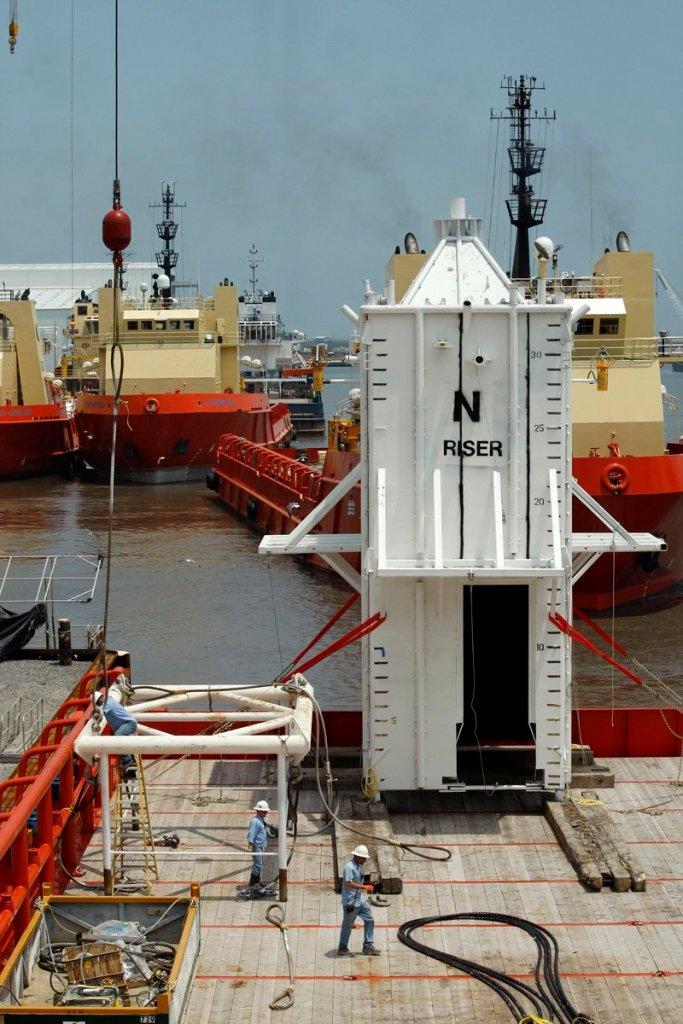PORT FOURCHON, La. – A 12-man crew was making final preparations Wednesday to take a 100-ton contraption 50 miles off the Louisiana coast in an unprecedented attempt to help funnel out oil spewing from the bottom of the Gulf of Mexico.
The giant-concrete-and-steel box is the best short-term solution to bottling up the disastrous spill that threatens sea life and livelihoods along the Gulf Coast.
BP PLC chief operating officer Doug Suttles said it would take about two days to put it precisely on the seafloor.
“It is very complex and we’ll likely have challenges along the way,” he said.
The pipes and tubing were to be hooked to a ship over the weekend, and if successful, the oil would eventually be brought to shore. The boat, a 280-foot vessel named the Joe Griffin, was expected to start its 100-mile trip around the Mississippi Delta later Wednesday.
The box is the latest idea engineers from oil giant BP PLC are trying after an oil rig the company was operating exploded April 20, killing 11 workers. It sank two days later.
Capt. Demi Shaffer said the trip would take 10 to 11 hours at a speed of 11 knots, or about 13 miles per hour.
Shaffer said the ship would wait at the Deepwater Horizon site for the arrival of another vessel with cranes that will lift the containment device and lower it 5,000 feet to the seabed.
Rusty Ledet, an operations coordinator for the company that owns the Joe Griffin and was aboard for the journey to sea, was asked whether the device would work. “I guess we’re all going to find out together,” he told The Associated Press.
The Joe Griffin, which also helped fight the rig fire after the Deepwater Horizon exploded, is owned by Edison Choest Offshore and is under contract to BP.
Coast Guard Rear Adm. Mary Landry cautioned about high expectations for the containment.
“So, please, I have to manage your expectations and just understand that our job is not done until this well is sealed, until this well is cemented, our job is not done till then,” she said.
She also said fires had been lit where the oil is heaviest.
BP is in charge of the cleanup and President Obama has said the company is responsible for the costs.
BP capped one of three leaks at the well Tuesday night, a step that will not cut the flow of oil but that BP has said will make it easier to help with the gusher.
Two satellite images taken Wednesday morning indicate oil has reached the Mississippi Delta and the Chandeleur Islands off the coast of Louisiana.
It’s not clear whether the oil is on shore, but it’s very close, said Hans Graber, director of the University of Miami’s satellite sensing facility.
U.S. Coast Guard Lt. James McKnight said crews remained at the Chandeleurs on Wednesday after officials got a report of oil coming ashore, but they have not located it.
“They’re sitting there, basically, waiting for the first signs of any kind of a sheen to touch the islands,” he said.
Graber said the images also show oil drifting south, toward the Loop Current, which scientists say could carry it toward Florida and the Florida Keys. The northern edge of the current may have already picked up some oil.
Florida officials fearing tourists will cancel their vacations are trying to quash rumors that oil is already washing up on beaches there.
“We are not two or three days away from it hitting the shore,” said David Halstead, Florida’s emergency management chief. “The beaches are still open.”
Send questions/comments to the editors.



Success. Please wait for the page to reload. If the page does not reload within 5 seconds, please refresh the page.
Enter your email and password to access comments.
Hi, to comment on stories you must . This profile is in addition to your subscription and website login.
Already have a commenting profile? .
Invalid username/password.
Please check your email to confirm and complete your registration.
Only subscribers are eligible to post comments. Please subscribe or login first for digital access. Here’s why.
Use the form below to reset your password. When you've submitted your account email, we will send an email with a reset code.